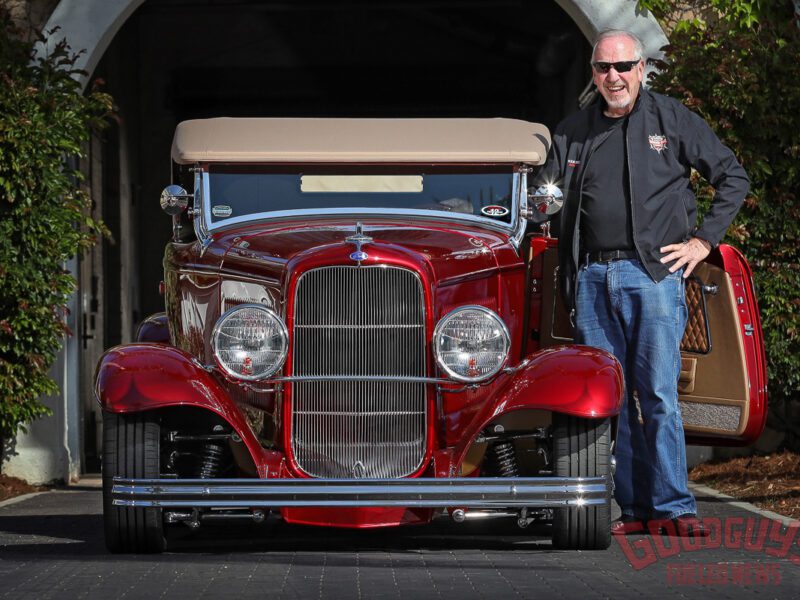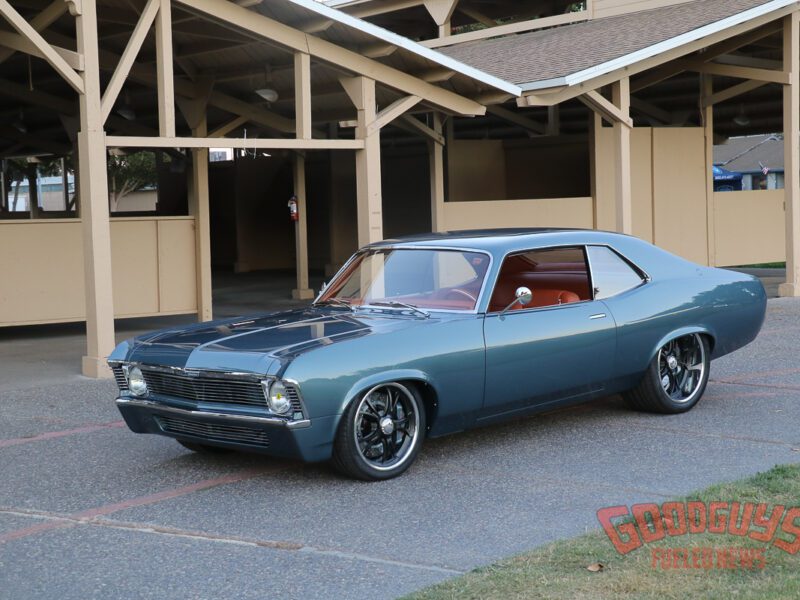Artist Sketchpad, A look beyond 73rd Street
As we inch forward through the new millennium, hot rodders have an opportunity to take a peek at new realities and to enter a 2018 Goodguys event. Recently, we asked some of the best illustrators in our industry to take a look past 73rd street and give us their take on post gas crunch cars and trucks.
As usual, they came through, focusing their pens on some of the most workable options from the ‘70s and ‘80s. Their vision gives us a great hope! – Editor
1975-76 Chevy Laguna

“A few years ago I was discussing a new project with a friend – a killer 1975-76 Chevy Laguna. We enjoyed building it in our heads, but since most classic car events have a cut-off year of 1972 we feared we couldn’t take it to mainstream hot rod events, so the project was dropped. Luckily, times are changing and here we are exploring these post 72 American vehicles. My goal was to add a lot more “sport” to this “luxury sport” coupe with a more aggressively designed front end with a lower splitter and extended rockers. The clunky rear bumper is reshaped to fit tight to the body and painted body color. A low-profile rear deck spoiler adds a bit of downforce. Indents in the hood add some detail and rear brake cooling ducts in the lower quarters are a functional design element. I gave it a classic black and charcoal two-tone with gold/orange stripe to add a bit of color. Add an upgraded chassis, suspension, and drivetrain and you’ve got a wicked mid-seventies street machine!
1973 Street Fightin’ ‘73 Maverick
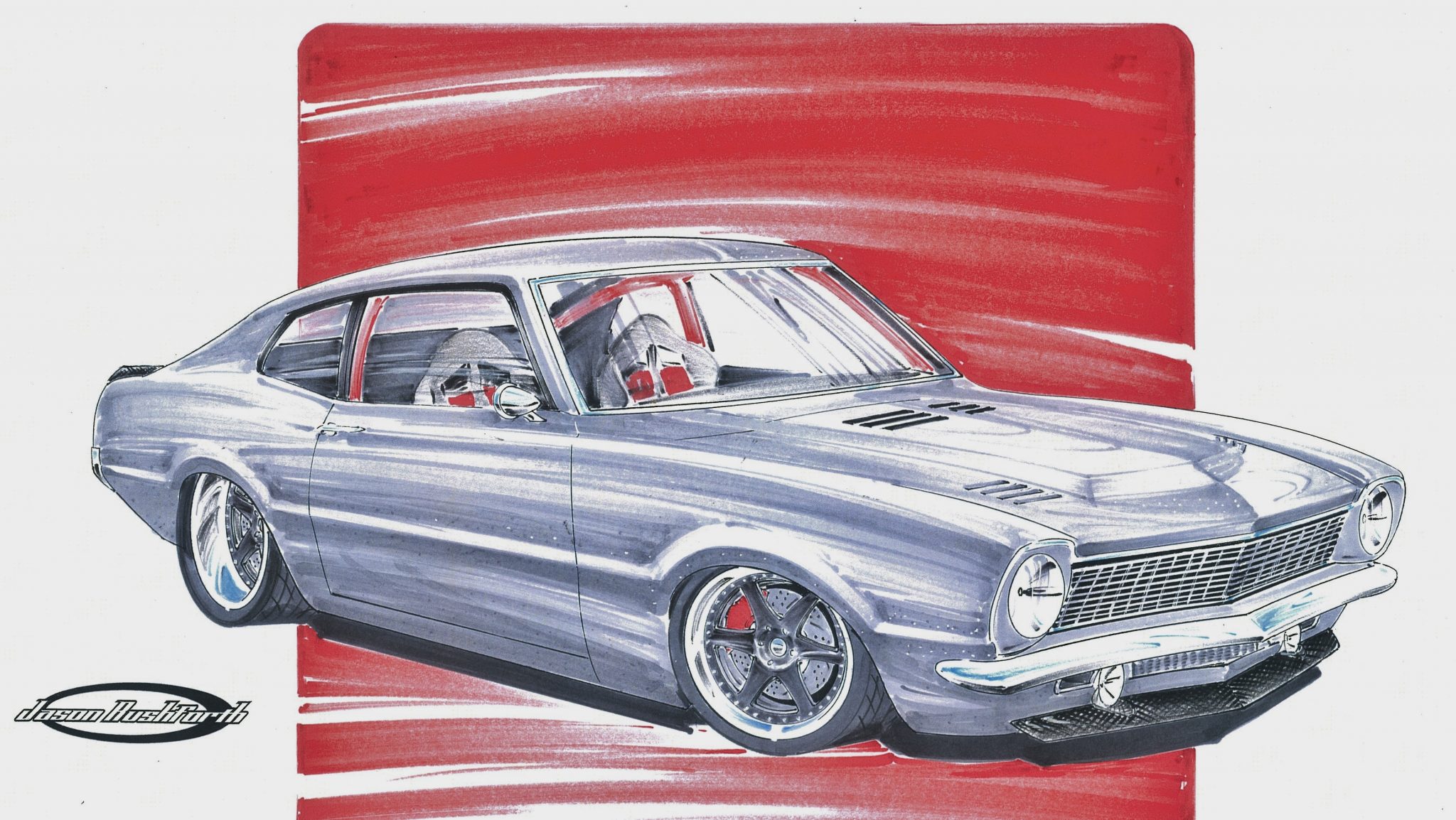
“Ford only made this body style for six years and it’s widely ignored, likely because, at the height of the muscle car craze, it was debuted with a 6 cylinder as an economy car. By the time Ford offered the V8 Grabber option a year later, horsepower levels were plummeting while insurance rates were climbing and it was basically too little too late.
The Maverick has great styling and proportions, a little smaller than a Mustang with a more useful interior but a lot smaller than a Torino and most of its other 70s contemporaries. Since bumpers got big on most cars in 1973 and these cars aren’t bringing crazy money, I suggest using a 70-72 front clip and matching rear bumper whichever year you start with. Up front, I sunk some spotlights into the valance sitting right above the carbon chin spoiler and a matching trunk spoiler out back to go with the street fighting theme and attitude. I added inverted louvers in the front of the hood on both sides and some slots centered in the rear to vent the heat coming off that turbocharged Coyote motor you might install. Or the original 302 with a carb and intake swap if you’re working with a budget.
For color, I kept it simple with a coat of silver and to clean up the lines a little more, I went with a dark matte gray on the window surrounds and tied in the same finish on the centers of the 18″ Rushforth Six Shooters. For suspension, the most important thing is getting it down on the ground and that’s another area where the budget will dictate how you do it. The interior continues the street fighter theme with a red cage holding red harnesses that snake through the backrests of the racing buckets.”
1986 Silverado
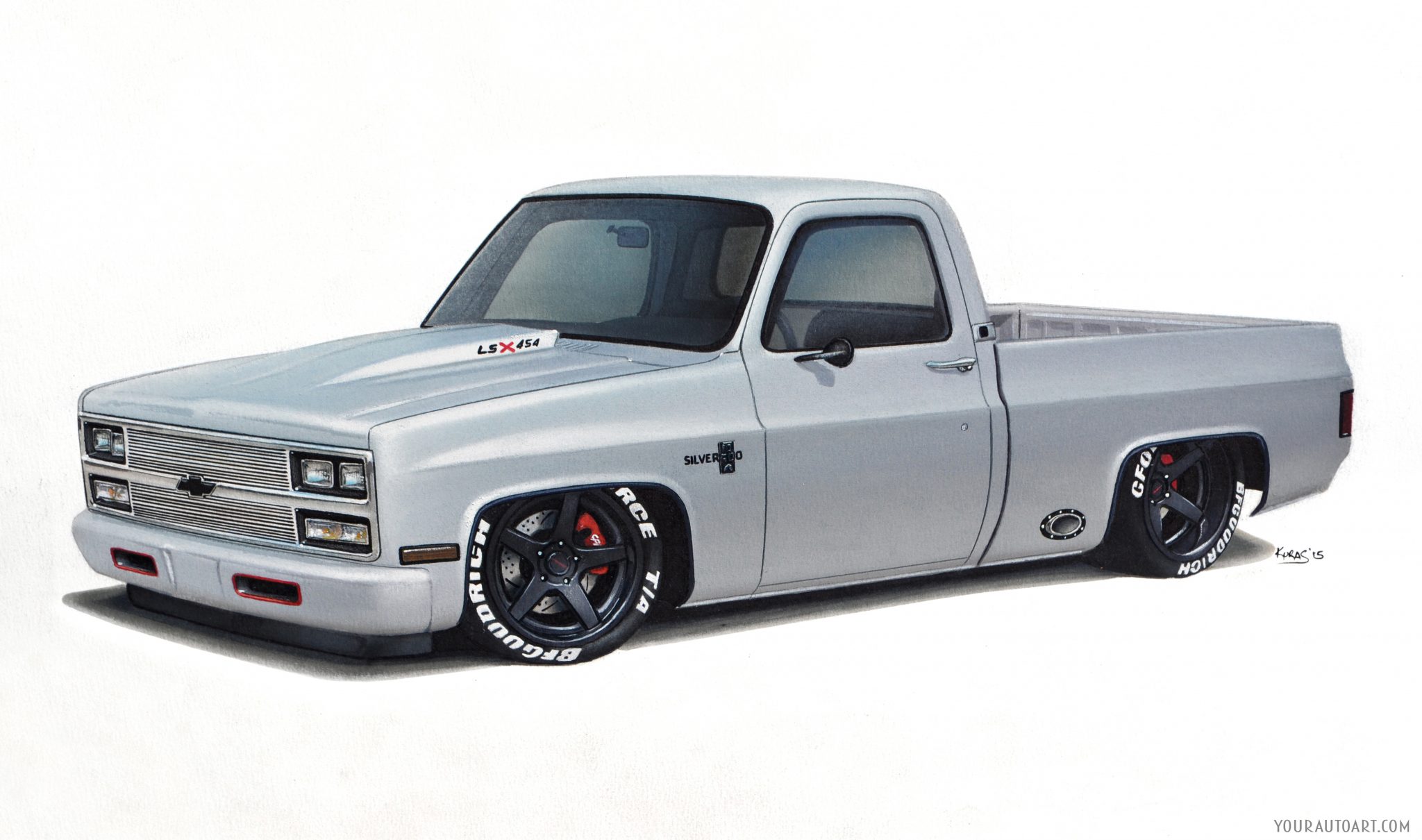
“This 1986 Chevy Silverado is under construction. Owner Tony Knight and Stafford’s Garage in Louisiana have teamed up on the build. You can build a C/10 like this with an aggressive suspension, modern drivetrain, and all the amenities that come in the finest luxury cars for a fraction of what it costs to build a muscle car or street rod.
The truck is called ‘Silver Bullet.’ We didn’t change much on the body. We tucked in the front bumper and removed the rear. Keeping the bumper on the front shows a little more ruggedness, and we added in some ducts to cool the brakes. We kept the duct design simple, working off of shapes from the 1991 C/10 grill that they put in allowing plenty of airflow to the LSX454 motor! The cowl hood carries the badging, and the colors of the badging were echoed around the truck.
The truck features a complete Porterbuilt suspension with the mild front drop member, step notch, and four link. AccuAir air and E-level air systems are in place as are CPP 2″ drop spindles, 13″ big brakes, and a Currie 9″ tru track with 3:70 gearing. The 700hp GMPP LSX454 crate engine (by Southern Performance) breathes through Kooks Stainless Steel 3″ exhaust and headers and is linked to a 4L85E transmission by Robert Godfry at Transbuilder Guy. Forgeline CF3Cs wheels measure 20×12 rear and 20×8.5 up front wrapped with BFG rubber and large white lettering.”
1986 Pontiac Grand Prix 2+2
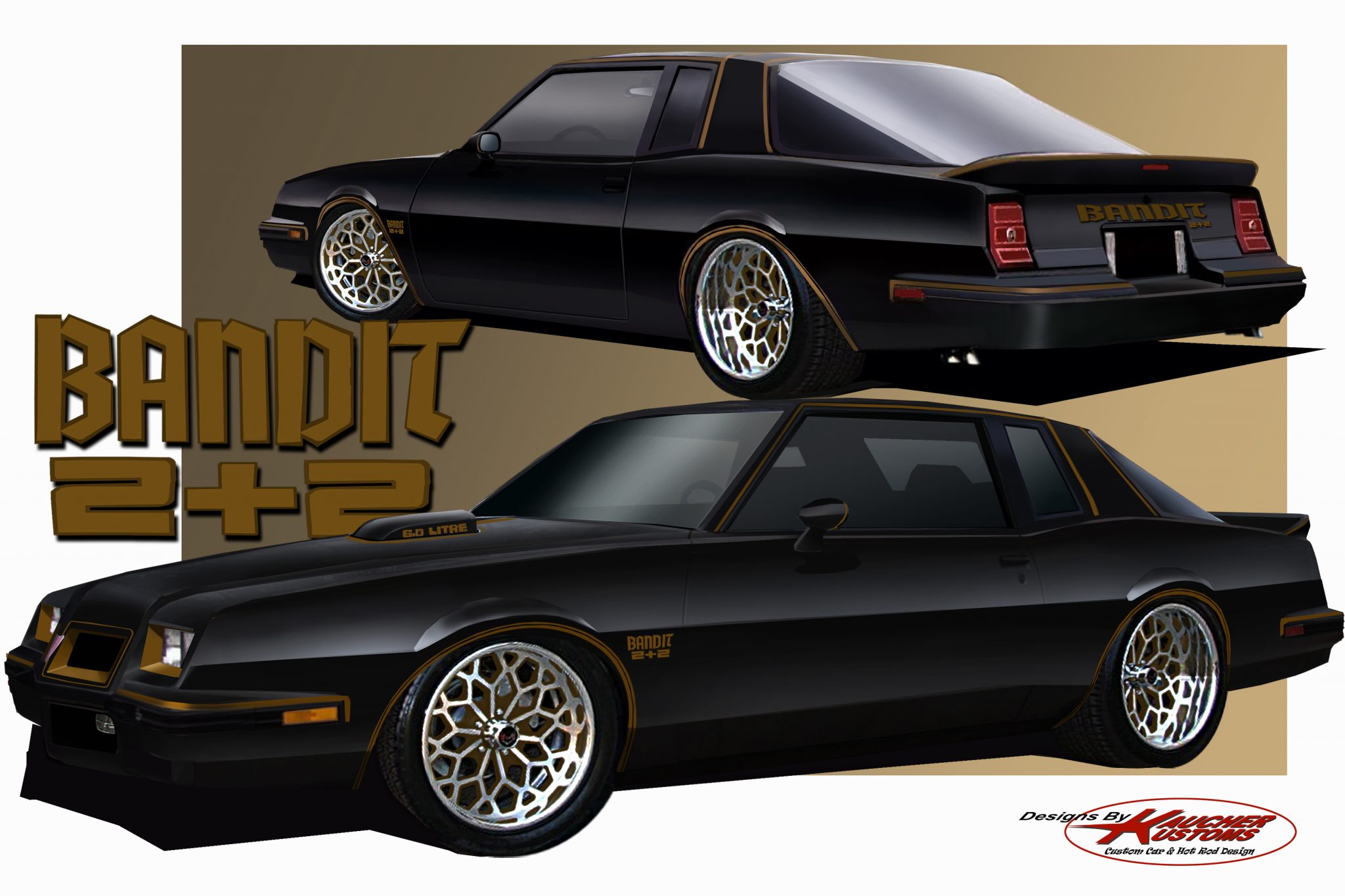
The Pontiac 2+2 is a car I designed for a client. It had clean lines that flowed well from the factory but needed some cleaning up. The front nose looked a bit cluttered with too much surface entertainment going on.
So I simplified the styling and flushed the bumpers up. The client, who is a major Pontiac fan, loves the Trans Am’s from the mid-seventies, with the screaming chicken graphics and wanted to take some of the Smokey flavor to his 2+2.
I felt the wheel arches were a bit too small and larger diameter rims looked pinched so I expanded them out, maintaining the oval shape. The car came together nicely with the associated black and gold paint scheme with the classic Trans Am fonts being used for the Bandit 2+2 nomenclature on the fenders and tail.
Ben Hermance – 76 Monte Carlo
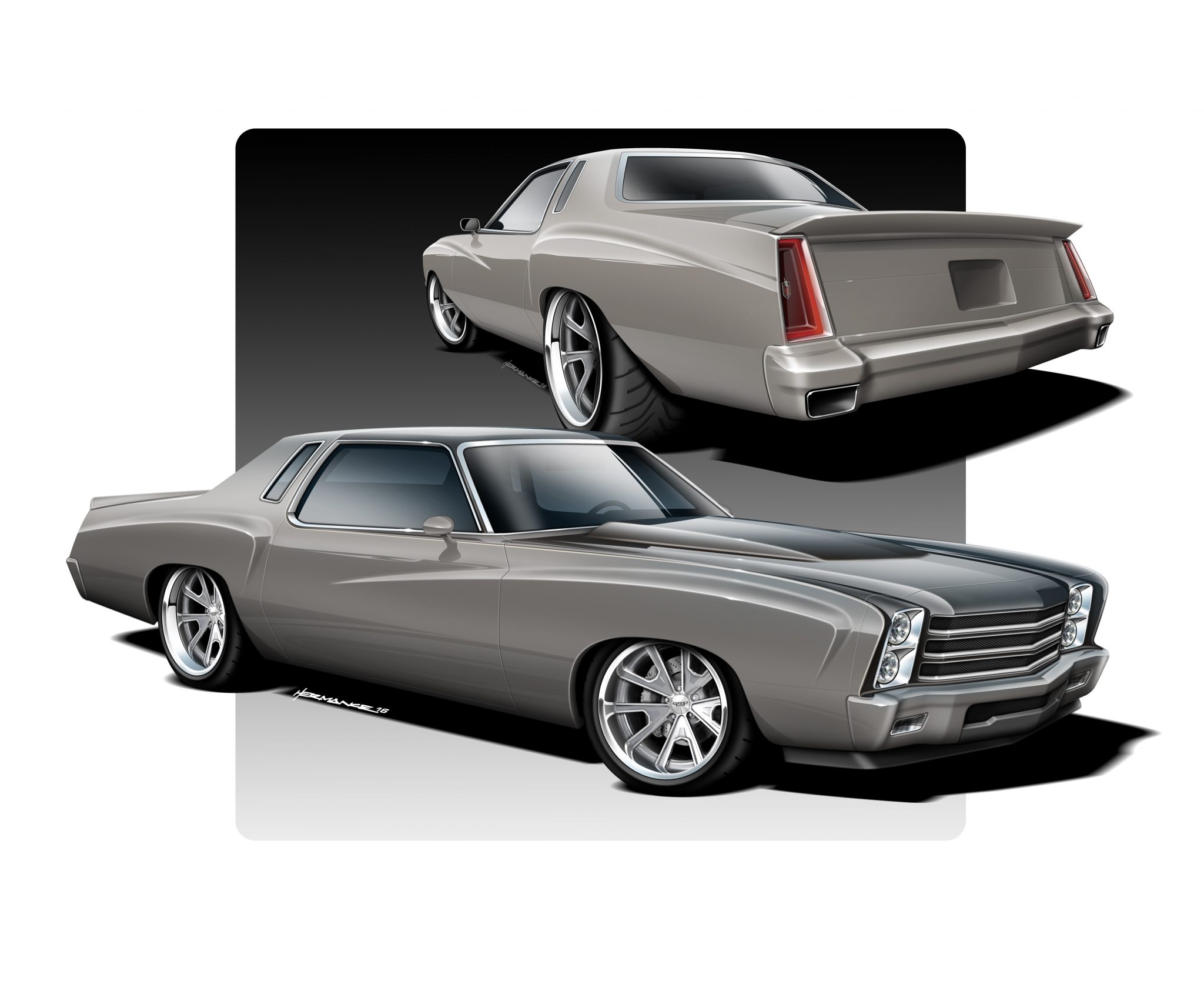
I’m a life-long Monte Carlo fan. My first and second cars were Montes (’85 and ’72 respectively) and I owned several mid-sized GM coupes after that. Personally, I feel like they’re nicely sized, offering a balance of comfort and potential performance. They’re one of the few vehicles during the ’70’s that retained a level of style while complying with regulations that strangled the industry. The long, sweeping fender creases, elongated nose, and vertical tail light arrangement allude to a more upscale car like an El Dorado. Though it lacks much of the heavy ornamentation found on a Caddy.
What I tried to do with this ’76 was keep the elements that are crucial to the genetic makeup of a Monte Carlo, and eliminate the less attractive and boring parts. After a lower, more aggressive stance and large-diameter 3pc forged wheels, I concentrated on the nose and tail. First I created a smoother and softer fascia that leans forward like the front fender creases. The center section including the grill are meant to resemble a sleeker ’70 Chevelle. I created custom headlight housings to adapt a round headlight arrangement. Portions of a ’71 bumper are grafted in, to reinforce the forward lean of the profile. I tucked it closer to the nose and painted it body color for an integrated look and added a lower air intake. It removes a lot of visual weight from the nose. The custom hood scoop adds muscular detail to long and mostly blank hood.
The rear required less work. The stock bumper is smoothed and tucked into the body with exhaust outlets passing through the corners so they are vertically aligned with the tail lights. The custom LED tail lights are frenched and are framed by a polished aluminum trim ring. A low profile ’80’s SS style rear deck spoiler gives it a sportier appearance.
The body could be adapted to fit one of the great aftermarket chassis that are available for high-performance A-bodies and it would be powered by a 650hp LT4 with a paddle-shifted 8L90 8-speed automatic as it’s more of a luxury sports car than track monster.



